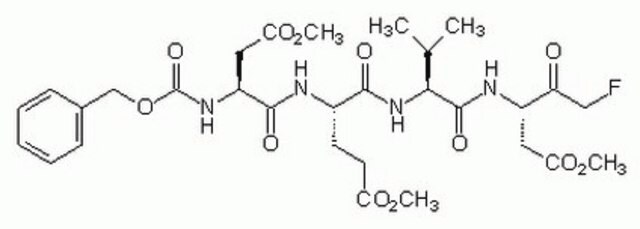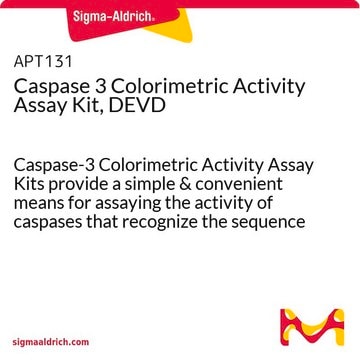235420
Caspase-3 Inhibitor I
The Caspase-3 Inhibitor I, also referenced under CAS 169332-60-9, controls the biological activity of Caspase-3. This small molecule/inhibitor is primarily used for Cancer applications.
Synonym(e):
Caspase-3 Inhibitor I, CPP32/Apopain Inhibitor, Ac-DEVD-CHO
About This Item
Empfohlene Produkte
Qualitätsniveau
Assay
≥90% (HPLC)
Form
solid
Hersteller/Markenname
Calbiochem®
Lagerbedingungen
OK to freeze
Farbe
white
Löslichkeit
DMSO: 5 mg/mL
water: soluble
Versandbedingung
ambient
Lagertemp.
−20°C
InChI
1S/C20H30N4O11/c1-9(2)17(20(35)22-11(8-25)6-15(29)30)24-18(33)12(4-5-14(27)28)23-19(34)13(7-16(31)32)21-10(3)26/h8-9,11-13,17H,4-7H2,1-3H3,(H,21,26)(H,22,35)(H,23,34)(H,24,33)(H,27,28)(H,29,30)(H,31,32)/t11-,12-,13-,17-/m0/s1
InChIKey
UMBVAPCONCILTL-MRHIQRDNSA-N
Allgemeine Beschreibung
Biochem./physiol. Wirkung
Capase-3, capase-6, capase-7, capase-8, capase-10
Verpackung
Warnhinweis
Sequenz
Rekonstituierung
Sonstige Hinweise
Thornberry, N.A., and Lazebnik, Y. 1998. Science 281, 1312.
Nicholson, D.W. 1996. Nature Biotech. 14, 297.
Schlegel, J., et al. 1996. J. Biol. Chem. 271, 1841.
Nicholson, D.W., et al. 1995. Nature376, 37.
Rechtliche Hinweise
Lagerklassenschlüssel
11 - Combustible Solids
WGK
WGK 3
Flammpunkt (°F)
Not applicable
Flammpunkt (°C)
Not applicable
Analysenzertifikate (COA)
Suchen Sie nach Analysenzertifikate (COA), indem Sie die Lot-/Chargennummer des Produkts eingeben. Lot- und Chargennummern sind auf dem Produktetikett hinter den Wörtern ‘Lot’ oder ‘Batch’ (Lot oder Charge) zu finden.
Besitzen Sie dieses Produkt bereits?
In der Dokumentenbibliothek finden Sie die Dokumentation zu den Produkten, die Sie kürzlich erworben haben.
Kunden haben sich ebenfalls angesehen
Unser Team von Wissenschaftlern verfügt über Erfahrung in allen Forschungsbereichen einschließlich Life Science, Materialwissenschaften, chemischer Synthese, Chromatographie, Analytik und vielen mehr..
Setzen Sie sich mit dem technischen Dienst in Verbindung.












